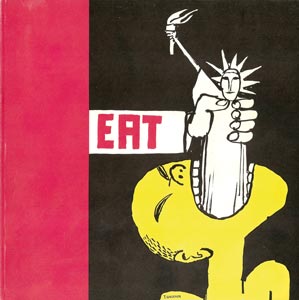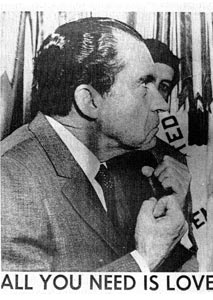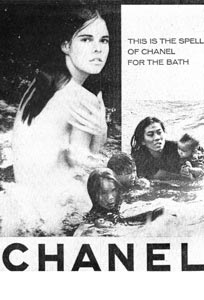Section by Jose Veigas
 Summer 1972. Before Chile brought me there, I was determined to see Cuba, the Revolution. The Viet Nam war raged. Where I was employed (University of California at Santa Barbara) I had joined the sporadic opposition to that war. Finding so many posters against it, which were of professional interest to me as a historian of graphic art and cartoon, as well as being politically opportune, I mounted an exhibition, adding related designs from the new culture of the Sixties. The exhibition was held at the university art gallery, with much success. It travelled to New York and Europe. In a not unconnected event, I got fired from my teaching post at the university, in the select company, I like to boast, of two distinguished visiting professors: Linus Pauling, twice Nobel Prize, for Chemistry and Peace, and sociologist Maurice Zeitlin, who had interviewed Che Guevara... I conferred with Zeitlin, who told me “just call these friends of mine in Cuba, and go.”
Summer 1972. Before Chile brought me there, I was determined to see Cuba, the Revolution. The Viet Nam war raged. Where I was employed (University of California at Santa Barbara) I had joined the sporadic opposition to that war. Finding so many posters against it, which were of professional interest to me as a historian of graphic art and cartoon, as well as being politically opportune, I mounted an exhibition, adding related designs from the new culture of the Sixties. The exhibition was held at the university art gallery, with much success. It travelled to New York and Europe. In a not unconnected event, I got fired from my teaching post at the university, in the select company, I like to boast, of two distinguished visiting professors: Linus Pauling, twice Nobel Prize, for Chemistry and Peace, and sociologist Maurice Zeitlin, who had interviewed Che Guevara... I conferred with Zeitlin, who told me “just call these friends of mine in Cuba, and go.”
Not so easy: There is an embargo, I have no Spanish and realize that my entrée into the Latin American Revolution should be a newer and more accessible, if geographically much more distant revolution, in Chile. We (writer Deena Metzger and I) arrive in Santiago in the summer of 1972, with an exhibition, a bundle of about a hundred posters, which delight the then director of the Palace of Fine Arts, Nemesio Antuñez, who has them hung immediately. His is an act of amazing spontaneity, like the Chilean revolution itself. I collect Chilean pro-Allende posters avidly. Meanwhile the Cuban cultural attaché in Santiago, Lisandro Otero sees the show, and invites us to bring it to Cuba the following year. We leave the posters in care of the Instituto de Arte Latinoamericano for Otero to bring back on one of his frequent trips back and forth; almost a very grave error. I get fired from the university (illegally: political activity is not ground for such action). The invitation to Cuba is a tremendous moral and professional compensation.
Arriving, after some delays, in Habana in late August 1973, as guests of the Consejo Nacional de Cultura, we find lavish hospitality and dedicated, generous guides, Alfredo Rostgaard, Fremez (Jose Fresquet), and Felix Beltran. But there is no sign of the posters. They arrive, finally, late for the planned opening at the San Rafael Galleria and only just before the savage counter-revolution of Pinochet, September 11. This destroyed the institute where we had temporarily housed the posters, and would certainly have destroyed the posters, along with any “socialist” material such as joined the notorious fascist bonfires in those dread days.
For the first time Habaneros see the variety, strength, and ingenuity (and sometimes grotesque) responses U.S. artists had to the Viet Nam war. Furthermore: was this actually the first exhibition in Cuba of U.S. art, otherwise known only from magazines, and in the form “purified” of politics as so much art necessarily was in those days? Representing just about as many different artists as there were posters, the show offered a rich eclectic view of other possibilities. Not that Cuban poster art did not have its own dynamism and originality, far from it; but there was in the U.S. palette of styles a certain graphic abandon, an irreverence, a vulgarity and frivolity even, which the Cubans found refreshing.
 I still struggled with Cuban Spanish, but it was with a mixture of delight and sorrow that I found I understood every word of Fidel’s splendid hours-long commemorative speech on the 9/11 coup in Chile and the heroic death of Salvador Allende. As a foreigner, even if not of that favored brand which got greeted in the streets (and applauded) as a “tovarich,” I found myself in the million-strong crowd attending the rally ushered forward so close to Fidel on his tribune, I was afraid of being thought a security risk. Fidel seemed to have little security around him, despite the string of well-known assassination attempts against him.
I still struggled with Cuban Spanish, but it was with a mixture of delight and sorrow that I found I understood every word of Fidel’s splendid hours-long commemorative speech on the 9/11 coup in Chile and the heroic death of Salvador Allende. As a foreigner, even if not of that favored brand which got greeted in the streets (and applauded) as a “tovarich,” I found myself in the million-strong crowd attending the rally ushered forward so close to Fidel on his tribune, I was afraid of being thought a security risk. Fidel seemed to have little security around him, despite the string of well-known assassination attempts against him.
My poster exhibition was held in the San Rafael Galleria, each item framed in wood. I remarked on how much work this was (we never did this at home); “Cubans are not afraid of work,” I was told. Nor was I afraid of theft, such as happened to the exhibition several times in the U.S., and in Chile. So many posters were left over from the space in Habana that it was decided to take the excess to Santiago for an exhibition there. I went with Rostgaard, native of that city.
The San Rafael exhibition, opening late, was due to last longer than the Consejo de Cultura had planned for our stay. At the risk of causing a diplomatic incident –there is nothing worse than a guest outstaying his welcome– I explained to my hosts that while my compañera was ready to leave, I could not do so without taking the exhibition (two exhibitions) with me. Forgoing my faithfully attentive guides, who returned to their regular duties, I settled down by the swimming pool of the luxurious Habana Libre, to start my translation of Para Leer al Pato Donald by Ariel Dorfman and Armand Mattelart, who were then escaping from Chile for their lives. My translation of and introduction to this classic of Marxist cultural criticism, which went into many editions in the U.S. (under the title How to Read Donald Duck: Imperialist Ideology in the Disney Comic) and other countries, has played an important part in my life. It even became an incident in U.S. censorship, when the U.S. Customs Dept detained it on grounds of probable infringement of Disney copyright.
One incident deriving from the hanging the Viet Nam posters exhibition sticks in my mind: expecting to include, against the advice of Felix Beltrán, one of my favorite posters, which I had put on the poster and cover of the catalog for the show in the U.S. The design was by Tomi Ungerer, by then already one of the best known caricaturists, illustrators and poster designers in the U.S. It showed, to the pop-art style command EAT, a powerful U.S. arm shoving the Statue of Liberty down the throat of a hapless Vietnamese peasant, inevitably caricatured. “No lo pondría,” says Beltrán. Why? “Because it shows the Vietnamese as humiliated, passively suffering U.S. interference.” I realized that historically this was proving untrue, Ungerer’s idea was slanderous in its way, and that Beltrán was right not to want Cuba to appear to be condoning an insult to an ally and fellow-victim of U.S. imperialism. If the poster did go up, I hope it was with a cautionary label. It was an important lesson to me: a design that was funny, clever and aesthetically satisfying, and evidently made to ridicule U.S. policy, could malfunction politically in a non-U.S. context.
 At the end of my stay there came a singular moment of triumph. Having expressed to Rostgaard how much I needed for future exhibition in the U.S. the extensive Vietnam and Moncada series by René Mederos, which had transfixed me from so many shop windows and office walls, and having reluctantly accepted the fact that the series, given out massively to embassies and foreign dignitaries, was simply no longer available, imagine my delight when lo! The day before my departure Rostgaard shows up carrying a huge pile of paper treasure, the two coveted Mederos series. These have served us well inside and outside the U.S., especially in a one-man show of Mederos poster art at my University (now UC Los Angeles), on which occasion (in 1991) he also did a 10 by 24 foot mural as a frontispiece of an exhibition of art from the Viet Nam war. It remains, I am sure, the only piece of monumental art by a Cuban from Cuba in the U.S. All René would accept in exchange for his work was some pocket money and materials –brushes and paints. He remains for me a symbol of typical Cuban generosity, like the artists –Beltrán, Fremez, Rostgaard– who with their gifts laid the foundation of the superb Cuban poster collection that we can boast of at the Center for the Study of Political Gra-phics, of which I am a director. Cuba has been an important part of my life, and I am happy to be collaborating again in the much-revived world of Cuban poster art.
At the end of my stay there came a singular moment of triumph. Having expressed to Rostgaard how much I needed for future exhibition in the U.S. the extensive Vietnam and Moncada series by René Mederos, which had transfixed me from so many shop windows and office walls, and having reluctantly accepted the fact that the series, given out massively to embassies and foreign dignitaries, was simply no longer available, imagine my delight when lo! The day before my departure Rostgaard shows up carrying a huge pile of paper treasure, the two coveted Mederos series. These have served us well inside and outside the U.S., especially in a one-man show of Mederos poster art at my University (now UC Los Angeles), on which occasion (in 1991) he also did a 10 by 24 foot mural as a frontispiece of an exhibition of art from the Viet Nam war. It remains, I am sure, the only piece of monumental art by a Cuban from Cuba in the U.S. All René would accept in exchange for his work was some pocket money and materials –brushes and paints. He remains for me a symbol of typical Cuban generosity, like the artists –Beltrán, Fremez, Rostgaard– who with their gifts laid the foundation of the superb Cuban poster collection that we can boast of at the Center for the Study of Political Gra-phics, of which I am a director. Cuba has been an important part of my life, and I am happy to be collaborating again in the much-revived world of Cuban poster art.
UCLA, April 9, 2011
Related Publications

How Harumi Yamaguchi invented the modern woman in Japan
March 16, 2022












